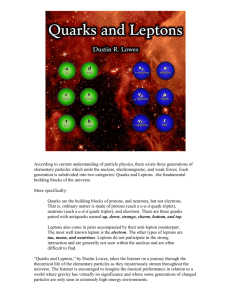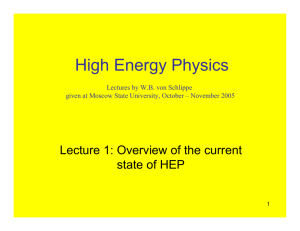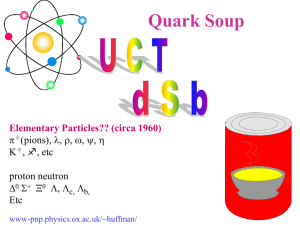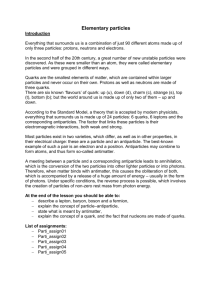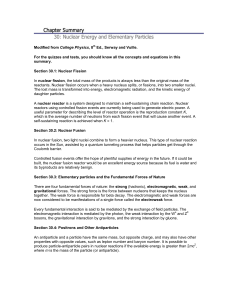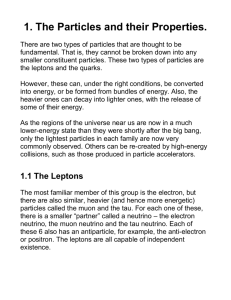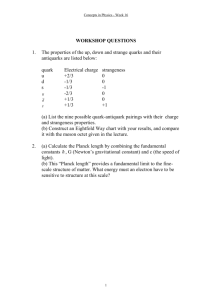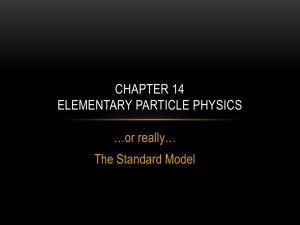Chapter 36 Elementary particles - E
advertisement
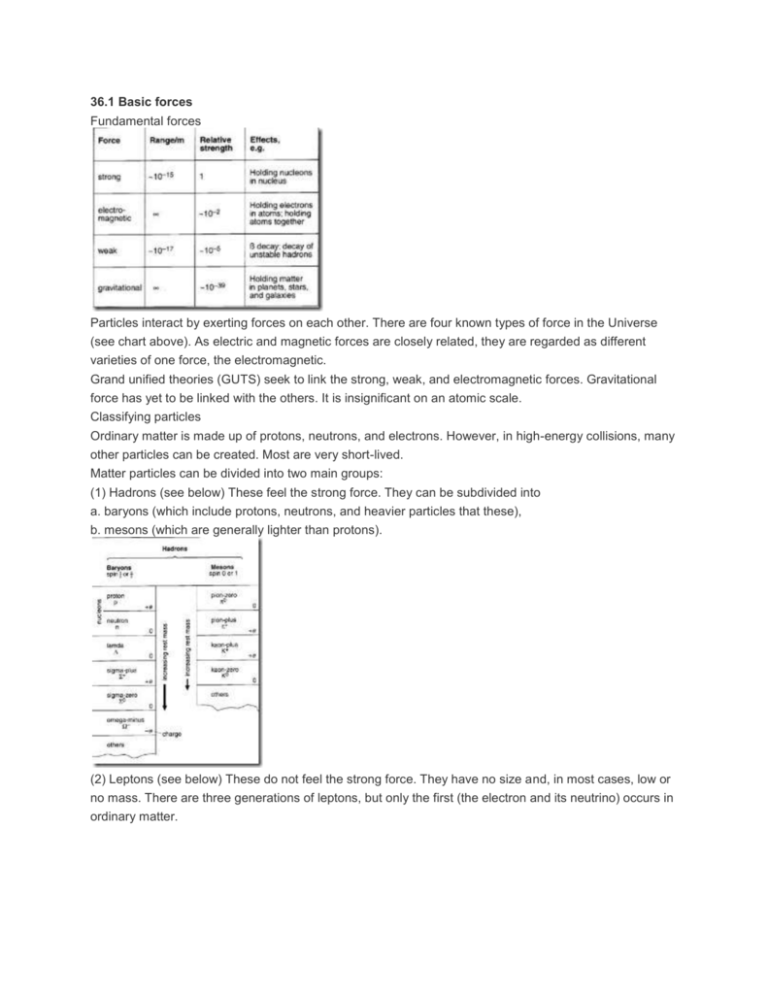
36.1 Basic forces Fundamental forces Particles interact by exerting forces on each other. There are four known types of force in the Universe (see chart above). As electric and magnetic forces are closely related, they are regarded as different varieties of one force, the electromagnetic. Grand unified theories (GUTS) seek to link the strong, weak, and electromagnetic forces. Gravitational force has yet to be linked with the others. It is insignificant on an atomic scale. Classifying particles Ordinary matter is made up of protons, neutrons, and electrons. However, in high-energy collisions, many other particles can be created. Most are very short-lived. Matter particles can be divided into two main groups: (1) Hadrons (see below) These feel the strong force. They can be subdivided into a. baryons (which include protons, neutrons, and heavier particles that these), b. mesons (which are generally lighter than protons). (2) Leptons (see below) These do not feel the strong force. They have no size and, in most cases, low or no mass. There are three generations of leptons, but only the first (the electron and its neutrino) occurs in ordinary matter. • All leptons and most hadrons have corresponding antiparticles. • The neutrino, v, produced by beta decay is the electronantineutrino ve. Conservation laws There are conservation laws for momentum and total energy. However, as mass and energy are equivalent, the total energy must include the rest energy (see G6). Particles have various quantum numbers assigned to them. These are needed to represent other quantities which may be conserved during interactions. For example: Charge In any interaction, this is conserved: it balances on both sides of the equation (see G1 for examples). Lepton number This is +1 for a lepton, -1 for an antilepton, and 0 for any other particle. For example, a ‘free’ neutron decays, after about 15 minutes, like this: neutron -~ proton + electron + antineutrino (0) (0) (+1) (-1) The numbers (in brackets) have the same total, 0, on both sides of the equation, so lepton number is conserved. This applies in any type of interaction. Baryon number This is +1 for a baryon, -1 for an antibaryon, and 0 for any other particle. It is conserved in all interactions. Strangeness This is needed to account for the particular combinations of ‘strange particles’ (certain hadrons) produced in some collisons. It is conserved in strong and electromagnetic interactions, but not in all weak ones. Charm relates to the likelihood of certain hadron decays. Spin relates to a particle’s angular momentum. Topness and bottomness are further quantum numbers. 36.2 Quarks Quarks The properties and quantum numbers of hadrons can be accounted for by assuming that each particle is a combination of others, called quarks. These have a fractional charge of +3 e or -3 e. Symmetry theory predicts that there should be three generations of quarks to match the three generations of leptons. (For each type of quark, there is also a corresponding antiquark.) Note: • Ordinary matter contains only the first generation of quarks. Very high energies are needed to make hadrons of other quark generations. These hadrons quickly decay into first generation particles. • Individual quarks have never been detected. All known hadrons can be constructed from different quark (and antiquark) combinations. Examples are given above. • Baryons are each made up of three quarks. • Mesons are each made up of a quark and an antiquark. Kaon The kaon K+ has a strangeness of +1. The kaon consists of an u quark and an antistrange particle (charge + e, strangeness +1). Using the table, this gives the K+ the following quantum numbers: charge +1 strangeness +1 Force carriers Like other particles, nucleons need not be in contact to exert forces on each other. To explain how the strong force is ‘carried’ from one nucleon (e.g. neutron) to another, the idea of exchange particles is used: Each nucleon is continually emitting and reabsorbing virtual pions, which surround it in a swarm. When close, two nucleons may exchange a pion. The momentum transfer produces the effect of a force (attractive or repulsive). Note: • The emitting nucleons lose no mass, so virtual pions are only allowed their brief existence by the uncertainty principle. To create ‘real’ pions, the missing mass must be supplied by the energy of a collision. All the fundamental forces are believed to be carried by exchange particles. For example, electrons repel each other by exchanging virtual photons. This process can be represented by a Feynman diagram as below. For ‘real’ photons to exist, energy must be supplied. The particles that carry the fundamental forces are known as gauge bosons. They are listed in the chart below. Note: •Quarks are bound together by gluons. As nucleons and pions are made of quarks, the gluon would seem to be the basic force carrier for all strong interactions. • The existence of the graviton is speculation only. 36.3 Neutrinos Neutrino Neutrinos are produced in radioactive decay which emit R-radiation. Neutrinos possess light speed, zero rest mass, are uncharged and do not react with matter. Neutron à Proton + Electron + Antineutrino Proton à Neutron + Positron + Neutrino
